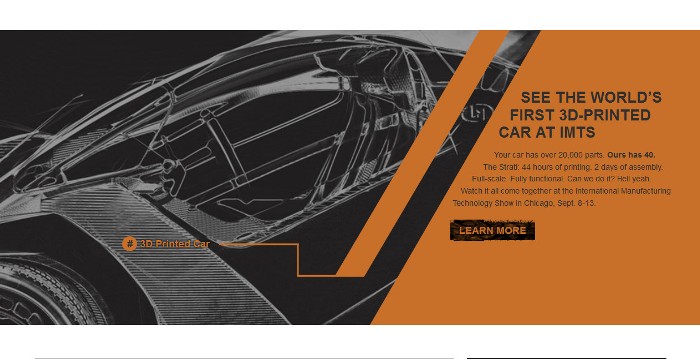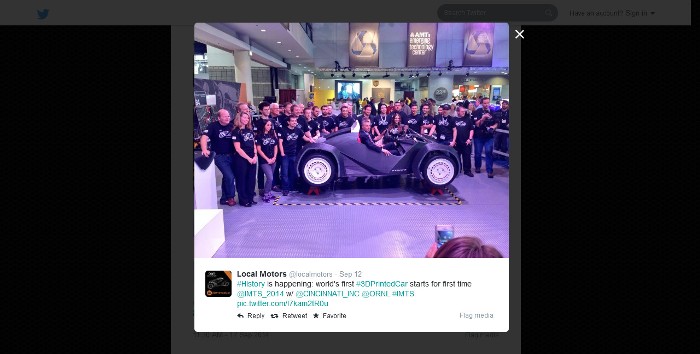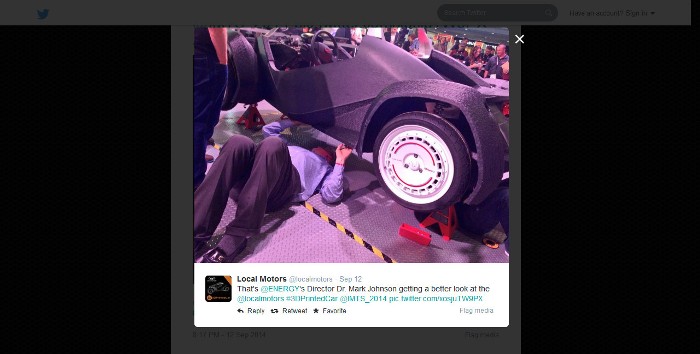3D Printed Car: Giving a New Meaning and Standard to Car Manufacture
Google’s driverless car is certainly making its presence felt especially as self-driving cars can now be considered legal in California. However, autonomous driving is not the only automotive technology worth celebrating. 3D printing tech has also been used in car manufacture and now has an actual product to demonstrate. Phoenix-based 3D printing company Local Motors has built a 3D printed car made of carbon fiber plastic. If proven to be usable, this could spell an important advancement for the car manufacturing industry.
The Strati
Local Motors claims to have produced the first car with a 3D printed body and chassis – the Strati. Some may disagree that it is not the first 3D printed car since the Urbee 2 was introduced back in November 2013 and was also created using 3D printed parts. However, unlike Urbee 2, the Strati is almost entirely made of 3D printed parts. Hence, it is virtually made of plastic, although not the flimsy type of plastic you would probably be imagining.
On their official website, Local Motors say that the car has around 40 parts compared to the more than 20,000 found in traditional cars. The car parts were produced after a total of around 44 hours of printing. Assembly, on the other hand, took approximately two days. The Strati is a full scale vehicle and is also fully functional. The completed 3D printed car was showcased at the International Manufacturing Technology Show (IMTS) in Chicago.
Plastic?
Yes, this 3D printed car is made almost entirely of plastic. However, this is not any ordinary plastic. It is a carbon reinforced plastic. The material would seem unusual for a car but Steve Russell of the American Chemistry Council says that the plastic used in the Strati is a material that is already gaining popularity in vehicle manufacture use. According to Russell, “carbon fiber reinforced plastics are 50% lighter than steel, and 30% lighter than aluminium.” However, Russell adds that “it has 12 times higher energy absorption,” which means better durability or resistance to stress.
All these highlight features of the carbon fiber plastic used in the 3D printed car supposedly make for better fuel efficiency and safety. In many of today’s cars, carbon fiber polymers or plastics may already comprise around 50% of a car’s volume while only contributing to around 10% of the vehicle’s total weight.
Challenges in the Manufacturing Process
3D printing a car isn’t all the good and convenient stuff. There are also challenges encountered along the way, engineering puzzles that require deeper understanding and innovations. Specifically, the challenge is about using the carbon fiber additive. Adding it to molten plastic isn’t as simple as mixing cement that already has established standards when it comes to the amounts to be used. It’s important to be precise with the amount of carbon fiber to be added to the polymer and there is no established standard on the right amounts to use yet. Russell says that “part of the secret sauce in knowing how much of it to add, when to add it, and getting the curing to spit out of the 3D jet at exactly the right time — that’s really where the intellectual property resides.” Of course, it’s not going to be surprising if Local Motors will be patenting the mixture and procedures they used since they are doing some pioneering work and it will be unfair for others to simply copy what that have worked hard to achieve.
Benefits of 3D Printing
Local Motors is focusing on the use of a hybrid additive/subtractive machine being developed at Oak Ridge National Labs. This machine enables direct digital manufacturing (DDM) that will make vehicle production faster, easier, and less complicated. One of the major benefits of 3D printing a car is the ease of changing designs and implementing such changes more quickly and with minimal or even without the added costs. 3D printing also reduces production wastage. Edmunds.com senior analyst Bill Visnic comments that 3D printing a car “has the potential to be a real paradigm shift, a second industrial revolution.”
Outlook
The headline on Fox News is hardly an overstatement: “Local Motors 3D-printed car could lead an American manufacturing revolution.” Indeed, the benefits of 3D printing a car are substantial. By making car manufacture easier, faster, and cheaper, automotive technology should become more affordable and accessible to more people. The traffic problem is another issue but for now, seeing a better way for car production is definitely a boon. Moreover, this vehicle 3D printing technology is also bound benefit other sectors including the military, construction, as well as other forms of transportation (air and water).



